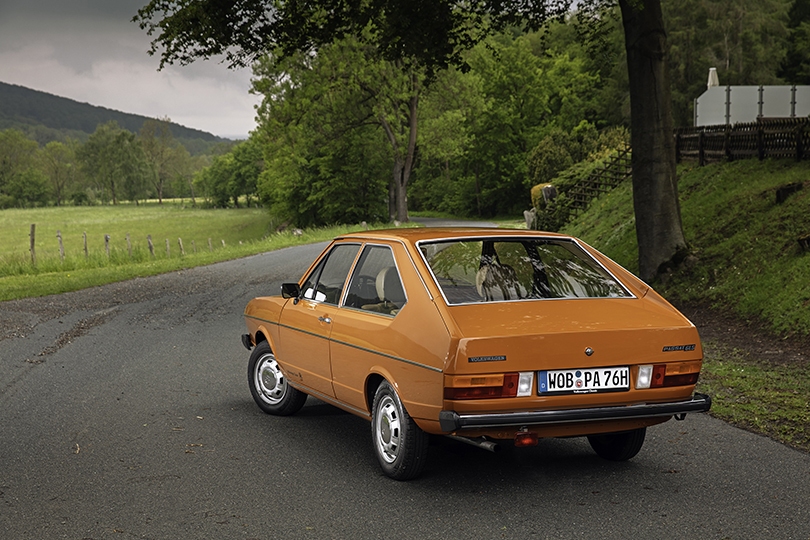In the automotive world, things move pretty quickly. Newer, faster, better. You all know the drill. So I was slightly surprised to get the offer to go and drive some old Volkswagens in Germany for a couple of days. Like, how do you mean, “old”?
As it turns out, driving cars that are not new — most of them quite ancient actually — can be remarkably refreshing. Slightly ironic too, I suppose. But most of all I guess that I was happy to see many cars again which I saw on the roads when I was barely enough to ride a bicycle. Well cared for, in a warm and dry environment to be preserved indefinitely. Best of all, on some rare occasions they still get to go outside and play. In this instance, a small group of journalists from Russia would be the first to be invited to take some of them for a spin.
![]()
The warehouse where these cars were stored and maintained was pretty much chock full of cars of various vintages. There were a large number of really old Beetles, and Golfs, but then you’d also have the odd racing car or even some cars that have no notable features except that they were used in a movie at some point. The cars that were lined up for us to try first were a pretty diverse mix as well: a 1977 B1 Passat, a 1972 K70, a 1974 Scirocco, a 1974 Karmann Ghia, a 1980 Beetle Cabriolet 1303, a 1973 Apal buggy, a 1989 Corrado G60 16V, a 1979 Iltis, a 1964 Type 3 sedan, a 1969 Type 147 Fridolin and a 1984 Golf 1 Cabriolet. Oh and last and very much least a 2005 Lupo 3L. That last one was a bit of a head scratcher, admittedly. But you get the idea — it was a very diverse handful of cars from VW’s rich history. There wasn’t quite enough time to drive each and every one, but I feel I got a pretty good taste for what life was like in the driving seat in the 1970s and 80s.
![]()
K70
I started off driving the 1972 K70, a car which had been in development by NSU at the time when they were bought by Volkswagen in 1969. It was definitely a modern design for the time, and its 90 horsepower 1.6 liter engine was quite powerful too. This was also a time when a 4-door family car like this only weighed 1060 kilograms. The single most difficult part about driving this car was probably the gearbox. The gear shifter had no markings of any kind on it, so you sort of had to guess where each gear was. The lovely VW employee who handed us the keys had given us an incorrect location for reverse gear too so that took a bit of guesswork. Once I found out roughly where each gear was, life was all right. It was impossible to find out exactly where they were anyway, as they seemed to shift location slightly every time you went to look for one. Not exactly the tightest shifter in the world, this. Once moving, the K70 was actually quite relaxing to drive. The most noticeable thing about cars of this era being that the steering wheels were incredibly thin.
![]()
Scirocco
Next up I had a short go in the original Scirocco. It was equipped not with the usual manual gearbox but instead with the much rarer 3-speed automatic transmission. I was quite eager to find out what a 3-speed auto from 1974 felt like, mostly expecting it to be really rather terrible, but it seemed surprisingly…normal. I mean, sure, it was sluggish as hell but really smooth and not all that different from the automatics that we know today. It’s just that we have 3 times more gears in them these days. The Scirocco was a rather sporty car back in its day, and some of that feeling is still there even if you drive it in 2019. It was certainly much easier and more dynamic to drive than the K70 which was only two years older.
![]()
Iltis
The 1979 Iltis, however, was a whole different story. It was the first real off-road vehicle by Volkswagen and their first all-wheel-drive one too. It very much drives like the light military vehicle that it was, not so much like a road car. These things absolutely bullied the Paris-Dakar rally in 1980 when they took three out of the four top spots including first place. This “Race Iltis” that I drove was loud, windy on the inside and generally terrifying to drive on a contemporary road at more than 60 kilometers per hour. It did feel surprisingly peppy when accelerating at low speeds, considering the 90 horsepower engine, but then it does have really short gear ratios for climbing those hills. Its top speed is a mere 130 kilometers per hour, though you’d have to pay me a lot of money to sit in one going that quick. Still, quite an experience.
![]()
Karmann Ghia
The Karmann Ghia and Beetle are essentially the same car in a different shape, which isn’t unheard of but this is probably an extreme example. The Karmann Ghia is one of those timelessly beautiful cars that will be in automotive design textbooks until humanity stops driving cars. The Beetle, on the other hand, looks more like…a Beetle. It will also be in textbooks forever as one of those cars that completely changed the automotive world. In terms of driving experience, the lighter, lower and more aerodynamic Karmann is obviously getting more joy out of its 50 horsepower air cooled engine but both were easier to drive than I had expected. Both also make the same sound, which is probably what matters the most. I can hardly think of a more iconic note than the one which the old flat-four spits out.
![]()
Beetle
![]()
At this point, my joy was slightly interrupted by ending up in the Lupo 3L. On the upside, I was suddenly very comfortable in a car that felt pretty much modern. On the other hand, it offered all the driving pleasure that you would expect from a car that is literally named after its (low) fuel consumption. Don’t get me wrong, it is very impressive how little fuel it uses. If that’s the kind of thing that turns you on, I’m not one to judge. I might look at you strangely for a moment, but then I’ll say no more about it. Anyway, this is a car from the enlightened year 2005 with no power steering. Because a power steering pump would put some drag on the engine and therefore use a bit more fuel. The gearbox is a robotized manual gearbox because a true automatic would’ve — you’ve guessed it — used more fuel. A few years later people had figured out how to make dual-clutch gearboxes that were brilliant. But this was before then. If you want to suddenly accelerate and floor the throttle, the first thing that happens is you slow down a bit. Because this gearbox puts itself into neutral and then goes about taking its time to select a lower gear that would make you go faster. I’m actually glad I got to drive the Lupo because it showed me like no other car did just how much better cars have become in the past decade and a half.
![]()
Lupo 3L
The last car I drove was one of my childhood heroes. Maybe I didn’t even realize it at the time, but looking back the Golf 2 GTI 16V (which was not originally included in our program but as we were all having such a good time some bonus vehicles were introduced) is fairly legendary. Cops used to drive them, probably because the bank robbers did as well. 139 horsepower from the 1.8-liter engine in a short wheel base car that barely weighed more than a ton was a pretty darn good recipe. I believe the one I drove was from 1992 or so, around the time that I started going to high school. It’s such an easy car to drive. The gearbox is quick and solid, the pedals are spaced perfectly and even the driving position isn’t all that bad for a tall guy like me. The engine is always egging you on to push on the loud pedal and it feels quick enough for what it is even in this era where from wheel drive “hot hatch” cars are topping 300 horsepower. The Golf GTI invented this class of cars single handedly, and it still has a thing or two to say about it. It’s a brilliant car still.
![]()
Golf 2 GTI 16V
Of course, all that having been said, if there is one thing that old cars make you realize it’s that we have it pretty good these days. Cars are so much quieter, more comfortable and everything you could want is right at your fingertips. Literally none of the cars I drove had power steering, which is really nice for the feel it gives you when the car is moving but it’s quite the workout if you want to maneuver at low speed or try to park. I guess people didn’t need Gym memberships back in the day, all you had to do was drive your car through a couple of supermarket parking lots to keep your muscle tone. Classic cars like these are awesome, and as a petrol head of course you’d want a couple of them in your garage. But chances are that you’d only take them out on a Sunday with nice weather, like you would your old grandmother.
Volkswagen is right to be proud of the cars they’ve made over the many decades that they’ve been in business. Some of them changed the world, others merely sold in stupendous numbers. But each and every model still works on the road today, in some form or other. None of them let us down over two days of driving, and we left with a smile on our face. Not that any of this is relevant for people looking to buy a Volkswagen today or tomorrow, but it’s great to see a manufacturer embrace the simple joy of nostalgic driving and share it with the rest of us. Because the best drives are often those made with no real purpose at all.
![]()
Corrado
![]()
SP2











